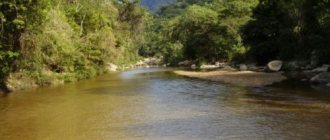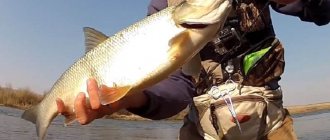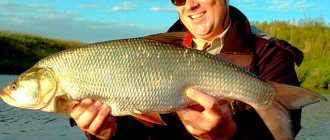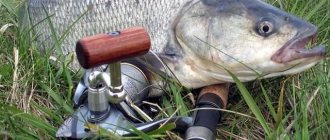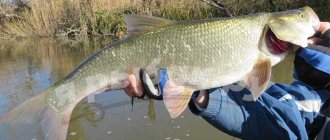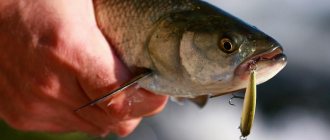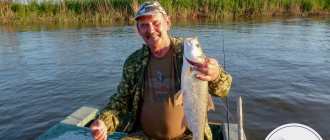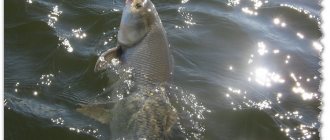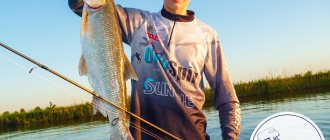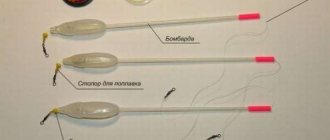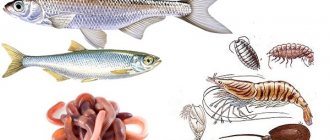The asp is a representative of the carp family. Representatives of this type of fish can grow to a length of about a meter, and their weight can even exceed ten kilograms. In our rivers, the only species from the carp family that is larger than the asp is the carp. Despite the fact that all members of the family are distinguished by their calmness, the asp is a merciless predator that consumes the young of many species of fish. The front fins of this fish look more like wings, the dorsal fin is quite high, and its tail is quite wide. A young asp can be confused with a bleak.
Features of catching asp with live bait
Catching asp with live bait begins in the summer, when the water has completely warmed up and the fish actively swims in the upper layers of the reservoir. It is worth noting that with the onset of cold weather, the fish goes into suspended animation and lies in deep holes. In the spring, with the onset of warmth, the asp does not show much activity, and what he does is constantly wait for prey. In the spring, catching asp with live bait is almost pointless. At this time, he bites exclusively on May beetles. With increased activity, you can expect a good catch using live bait.
It is recommended to use any small fish as live bait. These can be chub, bleak, goby and similar fish. When choosing live bait, the main thing is to comply with some requirements for this fish. The length of the live bait should not exceed eight centimeters, while the width of the fish should also not be very large. This is due to the fact that the asp will not be able to swallow large baitfish, and therefore will not bite.
It is recommended to attach live bait to a small tackle, which consists of two hooks. One of the hooks must be placed on the back of the fish. If you want to use only one hook, then the fishing result may disappoint you. Experienced fishermen recommend using fish species such as bleak and verkhovka as bait. It should be taken into account that such fish are delicate, and therefore it is necessary to bait them and hook the prey very carefully.
Note to the fisherman! Every fisherman should know that the asp has not only excellent eyesight, but also a sense of smell. He can easily distinguish the smell of a particular victim. In this case, the asp can determine the physiological state of the fish, be it its disease or state of excitement. For this reason, it is recommended to use various flavors for bait when fishing for asp.
How to find fish in deep water
Fishing in spring begins almost immediately after the ice has melted in deep-sea areas. At this moment, the fish begins to prepare for spawning and therefore does not appear in shallow water. Often the asp is located as far as possible from the shore, and just before spawning, it climbs to the depths, under steep banks.
Spawning begins approximately from April 23 to May 3, with a water temperature of 10-11 degrees. At this time, the fish bite in the range from 10 to 60 meters from the shore, which is much closer than in the summer.
Live bait for asp fishing
Although the asp is a predatory fish, it is toothless, for this reason you should not use large live bait when catching it. This fish predominantly feeds on young fish, since its size allows it to completely swallow prey. For this reason, catching asp with live bait involves using not just any fish as bait, but only small ones.
Read more:
Fishing for crucian carp on the lake
The length of the fish should range from four to seven centimeters. It is also worth noting that the asp will not be able to swallow very wide fish, for this reason the live bait should also not be very wide. Fish such as goby, dace, chub, gudgeon or bleak can serve as live bait. However, it is necessary to take small young animals, because they are the main diet of the asp in the summer.
The most popular types of fish among fishermen are bleak and verkhovka. They live in the upper layers of the reservoir, and quite often become victims of asps during hunting. Therefore, these types of fish will be the most preferable when fishing for asp. However, it is worth considering that the bleak and the top are quite delicate, so it is best to use a regular fishing rod rather than a spinning rod when fishing.
Promising places for fishing asp with donkey
Identifying a single asp is quite difficult.
For this reason, many fishermen first carefully study the area, determine its route of movement and feeding places at different times. In general, you have to spend a lot of time on such observations. The accumulated experience subsequently helps to accurately find places where asp can be caught. Single individuals sense danger very well. When the asp walks along the same routes, he quickly identifies new objects that have appeared on the shore. It could be a car, a tent, a person, a fire or something else. In this case, he will not peck.
Therefore, it is best to catch asp from behind cover. Let it be a bush or thicket. The main thing is to show less of your presence on the shore.
Promising places for fishing asp with live bait using a bottom fishing rod are areas below dams and spillways. Several flows often arise here in different directions, there are many whirlpools, and there are areas with reverse flow.
The asp often visits areas near pits. There he hunts for fry. Before you start fishing, be sure to scan the selected area with a weight to identify holes, drops and edges.
There is no need to say once again that only accurate casts to promising places will significantly increase your chances of catching an asp. You should cast a little further than the chosen point. After this, you should drag the live bait a little. You should also feed the live bait so that it is located slightly above the bottom. For this purpose, a rig with a spaced weight and a leash is used.
It is very important that the bottom in the fishing area is rocky or sandy. The fry prefers to stay in such areas, and the asp actively hunts for them.
Windy weather is favorable. Over a large stretch of river or reservoir, it is easy to detect areas where the main current collides with the current created by the wind. The asp loves to visit areas with strong wind currents. It often approaches the boundary between calm and moving water. Often a river stream carries a fry, and the asp does not miss the opportunity to take advantage of such a favorable moment.
Here is one typical example of the movement of an asp while hunting for fry. During the collision of the windy and main currents, schools of fry feed near the cape. At this time, the asp patrols along the coast and first visits the surf zone, and then moves to the border of the upper and lower currents, located behind the cape. Along this route, the white predator meets fry.
Another typical situation is typical for a large river. At one of the turns a rip current appears. Usually, in windy weather, a wind current arises here, which intersects with the main one. In such cases, schools of small fish gather, picking up larvae and other small food that washes out of the coastal zone. Naturally, the asp is also familiar with this situation and often visits such areas.
You can also observe current collisions in some bays. At the border of currents there is often a good food supply for fry. The asp also gathers there.
Sometimes aggregations of fry can be observed on large rivers and reservoirs. The result is bubbling cauldrons. Seagulls often gather near such places. The asp very quickly finds such areas and begins hunting. If you find such areas, then feel free to throw the tackle as accurately as possible into the boiler.
Tackle for catching asp with live bait
If you want to catch an asp using live bait, then you need to use the most ordinary tackle, with which you can release the bait. Such equipment can be a fishing rod with guide rings, which is equipped with a reel with no inertia, as well as a maximally inconspicuous float in the shape of a ball. In this case, it is imperative to equip your fishing rod with a leash. Its length should be approximately one meter, but longer leashes can be used.
The best option would be to use fluorocarbon as a leash, because this material is practically invisible in the water. When fishing, the tackle must be carefully held, and the live bait must swim ahead of the float. The line should be in a taut position. With such a tackle you can easily catch not only asp, but also chub, perch, or even pike.
Read more:
Catching ide
As live bait, you can use not only small fish, but also fairly large tadpoles or not very large frogs. If you are not a fan of fishing with live bait, you can immediately use a spinning rod to catch large specimens.
Note to the fisherman! The asp is a rather cautious and cunning fish, for this reason it is necessary to catch it using careful camouflage. At the same time, it is possible to catch a good asp only if the fisherman has perfect command of the gear and can bait well. It is extremely rare to encounter cases where young and inexperienced fishermen were able to catch an asp that was also quite large in size.
On what bodies of water can you catch asp?
In winter, asp can be caught on the river, in its non-freezing section. There are such places on all major blue highways in Russia. On the Volga, areas in the Astrakhan region do not freeze, and polynyas form near large hydroelectric power stations (Volzhskaya, Zhigulevskaya, Nizhnekamskaya).
On the lake, you can fish for asp only near the places where underground springs, streams or small rivers flow into the reservoir. The bite will be especially good near natural washouts. It is always better to catch asp in the morning (from 7 to 12 o'clock). Sheresper is active only during daylight hours. At dusk and at night it does not manifest itself at all.
Some fishing secrets
The asp bites quite strongly, and the fisherman can feel a kind of blow to the hand. The larger the fish, the stronger the jerk will be.
When an asp is hooked, it strongly resists, swimming in different directions and trying to escape. However, it is worth noting that the asp is a representative of those fish that are quite sensitive to pain, for this reason it can be fished out even when using gear with a thin fishing line. But no one canceled the accuracy of fishing.
It is not for nothing that the asp received the name “river corsair” among fishermen, because this particular fish can majestically plow the upper layers of rivers, inspecting its possessions. Catching an asp is a rather difficult task, therefore a caught trophy asp is of great value to a fisherman. Such fish testifies to the great experience and high skill of the fishing enthusiast.
What other gear is used?
In addition to a float rod, you can catch asp using bottom tackle, in which the live bait is located above the sinker and, due to its own movement and under the influence of the current, moves in the water column. However, this method has three significant drawbacks:
- The gear is in a limited space, and the angler may not get to the place where the asp is “fighting.”
- Live bait is located much below the surface of the water and can be invisible to this predator, which prefers the upper layers for hunting.
- When casting long distances with a load, there is a high risk of the fish falling off the hook when falling into the water.
Sometimes fishermen use a fishing technique such as Sbirulino (bombard) to catch sherespers. In fact, this technique is even closer to spinning fishing. Here, in order to cast a light bait to the required distance, a special weighted float called a bombard is used. It has a built-in weight or, before fishing, it is filled with water until the weight required for immersion is reached, and the fishing line is threaded through the entire length.
Tactics and fishing techniques
In the spring, when the asp has just recovered from winter, catching it with live bait is not very promising. At such times he is interested in worms and larvae. At the end of spring, many insects fly out, many of which, falling into the water, are an excellent bait for the asp. Effective fishing for sheresper with live bait begins in the summer. Only in the warm months does this predator become accustomed and begin to feed on fry and various types of small fish. Autumn is the period of trophy specimens of predators, so the size of live bait can be increased. The asp is a heat-loving predator that is most active on the hottest days. The best bite should be expected in the morning and evening, although during the day it can feed several times at very different times. The sheresper is very picky about the weather and will not bite during periods of changes in weather or atmospheric pressure. You need to go fishing for it when the weather is stable for several days.
The tactics for fishing with live bait is to move the bait downstream in promising places. To achieve a positive result, you have to lower the live bait over decent distances - 30 meters or more.
If fishing occurs from the shore, an element of camouflage for the fisherman is mandatory. Careful casting of the tackle should be done from behind a bush or other cover. If there are no shelters on the shore, then it is advisable to use a camouflage suit that matches the color of the shore and make a minimum number of movements when fishing. If there is an opportunity and the fishing location allows it, then you can go into the water, even if it’s hot. In this case, the sheresper will not be wary and the fisherman will not be afraid. The most convenient option for fishing for sheresper is fishing from a boat. In this case, the angler can fish any area of the reservoir without the risk of being noticed. And the asp is not afraid of fishermen from a boat, just as he is not afraid of those who enter the water.
Photo 3. Equipment diagram.
Promising places where asp can be successfully caught using live bait are the following elements of the reservoir:
- sandy rifts;
- places of current change;
- places behind the pier, bridge piles, dam;
- next to a snag or a tree sticking out of the water;
- under trees and bushes hanging over the water.
A clear sign of the accumulation of asp in some place of the reservoir is the presence of seagulls above this place, which periodically descend to the water and pick up the fry. This sign means that a flock of asps is feeding in this place, and at this moment you can launch a rig with live bait into this place.
Another sign of the presence of asp is constant outbreaks in one area. The fight of an asp is different from the fight of other fish. It resembles hitting water with a shovel. This asp jumps out of the water and hits the water flat. The presence of asp strikes indicates that the asp’s hunting trail passes through this area, and in such a place it is possible to launch a rig with live bait.
